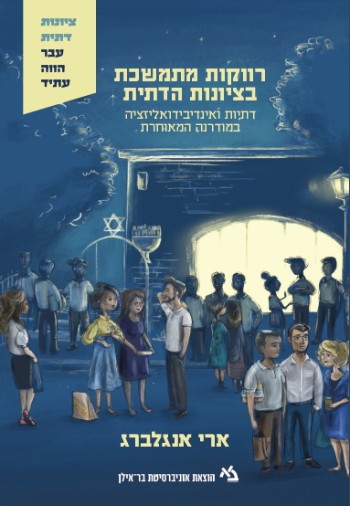
In late modernity a new reality has been created in Western societies: young people are in no hurry to get married and prefer to enjoy the freedom before they settle down, and at the same time expectations about relationships and marriage have changed. These changes are related to the processes of individualization and an increase in the importance of the individual. In recent decades, this phenomenon has also reached the religious Zionist public in Israel, and urban concentrations of single men and women have been created - the 'bachelor swamps'. In religious Zionism this phenomenon was perceived as a problem, and over the years various enterprises have tried to 'dry up the swamps'.
The book describes the encounter between religious Zionism and this global phenomenon as it is reflected in the narratives of religious single men and women. The questions at the center of the book are: What sets the courtship process apart in the Zionist-religious public and what can be learned from it about expectations regarding relationships? How do single men and women deal with the tension between the Western-liberal narrative that states that single years are used to accumulate experiences, and the religious view that encourages starting a family at a young age? What are the challenges facing single men and women in a religion that is family and community? And what is the position of rabbis and educators in relation to these issues? The book follows the fascinating story of those who are at the forefront of the encounter between Orthodoxy and late modernity and carve for themselves a new life path that previous generations of Torah and mitzvot observant Jews did not know.
Danacode: 110-20295 ISBN: 978-965-226-593-7 Language: Hebrew Pages: 240 Weight: 500 gr Dimensions: 17x24 cm Publication Date: 07/2020 Publisher: Bar-Ilan University Press
Introduction 11
Structure of the Book 12
Religious Zionism 13
Religion, Family and Singlehood in Religious Zionist Society 17 Clarification of Concepts: Modern Orthodoxy in Late Modernity 19
Methodology 23
Chapter 1: Romantic Love in Religious Zionism 29
From Arranged Marriages to Love Marriages to Intimate Relationships 30
Key Symbols in Religious Zionist Courtship and Marriage 35
Chapter 2: Romantic Love Ideologies: Rabbis, Writers, Poets and Singles 41
Rabbis 41
Deep Currents: Romantic Love in Religious Zionist Writing and Poetry 46
Between Rabbinical Discourse and the Singles Discourse 49
Summary and Discussion 56
Chapter 3: Religious Zionist Dates: Consumer Culture, Gender Relations and Aspirations for Intimacy 59
Religious Singles and Late Modernity 59
Consumer Culture and Courtship 60
Gender and Courtship 64
Conflicts Regarding Gender Roles 67
A Recurring Theme in the History of Orthodoxy? 75
Intimacy 79
Seeking Intimacy across the Gender Separation Gap 81
Seeking Intimacy under the Religious Zionist Courtship Norms 86
Summary 90
A Good Place in the Middle? Between Haredi and Secular Societies 92
Chapter 4: Religious Affiliation and Courtship and Marriage Scripts in Israeli Society 95
Changes in the Lifecycle in Upper Middle Class Society in the West and in Israel 95
Sectors and Lifecycle Scripts 97
Singles’ Ideal Marriage Age 103
Pressures to Marry at the Appropriate Age 105 Differences between Single Men and Single Women 111
Life between Scripts and the Fear of Falling between the Cracks 112
Summary 118
Chapter 5: Between Singles’ Social Networks and the Formal Community 121
A Comparative View of Singles’ Social Networks 122
The Religious Zionist Establishment and Singles’ Social Networks 125
Life in Singles’ Society 127
Mapping the ‘Swamps’ 127
Shabbat, Holidays and Weekdays 129
Shabbat as the Symbolic Heart of ‘the Singles Problem’ 130 The Boundaries of Singles’ Society: Separating the Married and the Singles 132
Ambivalence Regarding Singles’ Society 134
Craving and Despising Singles’ Society 134
Does Living among Singles Delay Marriage? 136
Singles in the Communal Synagogue 138 Does Singlehood Threaten ‘Family Values’? 142
Summary 146
Chapter 6: Religious Challenges: The Appeal of Western Youth Culture and Loneliness 149
Family and Religion 149
Singlehood and Religion: a Comparative Perspective 150
The Appeal of Youth Culture and Depressing Loneliness: Factors Distancing Singles from Devout Religiosity 153
The Appeal of Western Youth Culture 153
Gila 158
Neta 160
Loneliness, Anomie and Antinomian Behavior 161
Summary 165
Chapter 7: Facing the Religious Challenges 169
Moratorium: “This is the Current Situation, Next Year We’ll Do Something Else” 171
Tomer 172
Yoni 174
Analysis 176
Doubters and Boundary Testers 177
Dvir 177
Sharon 179
Analysis 182
Strictly Frum 185
Shai 185
Sara 186
Religious Women and Personal Relationships with God 188
Tamar 189
Sarit 190
Analysis 192
Summary and Discussion 195
Singlehood and the Spectrum of Religious Zionist Religiosity 197
Chapter 8: The Future: Individualization and Religiosity
201 Bibliography 211
Index 227


